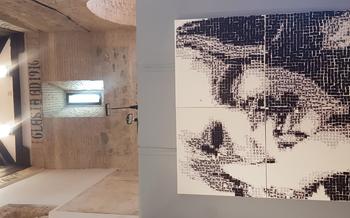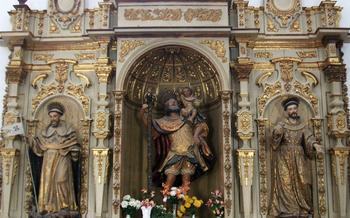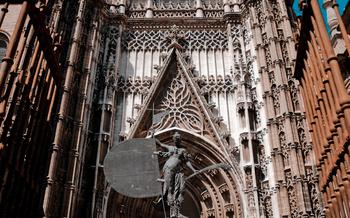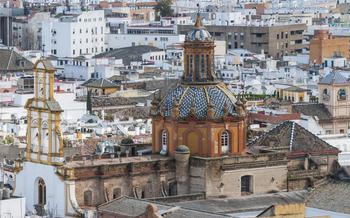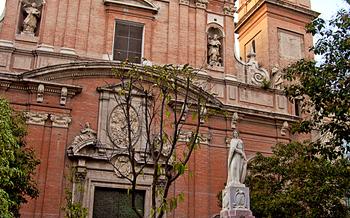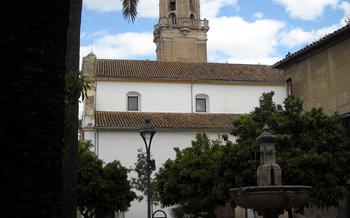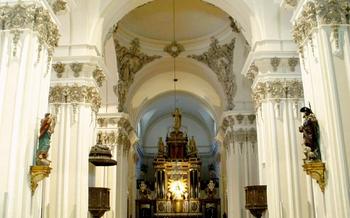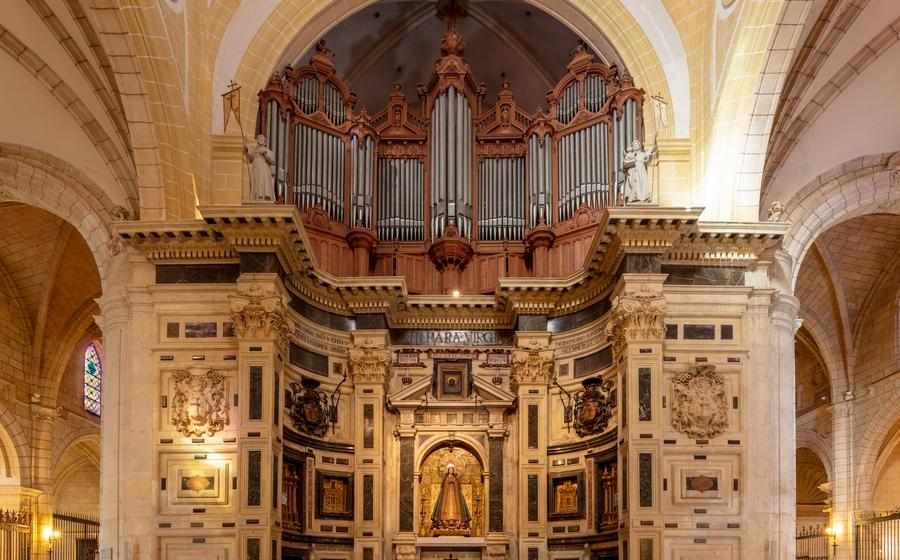
Catedral de Murcia (Murcia Cathedral)
- The Cathedral of Murcia: An Architectural Masterpiece
- A Journey Through History: Exploring the Cathedral's Past
- Unlocking the Secrets: Guided Tours and Audio Guides
- Exploring the Chapels: Hidden Gems of the Cathedral
- The Cathedral's Altarpiece: A Baroque Masterpiece
- The Throne of the Virgin: A Symbol of Devotion
- The Splendor of Stained Glass: Illuminating the Cathedral
- Musical Delights: Concerts and Performances
- The Cathedral Bell Tower: A City Landmark
- Murcia Cathedral Museum: A Treasure Trove of Artifacts
- Pilgrimage and Religious Observances
- Restoration and Conservation Efforts
- Opening Hours and Admission Fees
- Insider Tip: Secret Rooftop Terrace
The Cathedral of Murcia: An Architectural Masterpiece
The Catedral de Murcia, a majestic edifice standing tall in the heart of the city, is a testament to Murcia's rich history and cultural heritage. Its construction began in the 14th century on the site of a former mosque, a testament to the city's diverse religious past. The Cathedral's design reflects a harmonious blend of architectural styles, Gothic, Renaissance, and Baroque, showcasing the evolution of architectural trends over the centuries. Its imposing facade, adorned with intricate carvings and sculptures, narrates the stories of saints and biblical figures, drawing visitors into a realm of spirituality and awe.
The Cathedral's bell tower, a symbol of Murcia's skyline, rises gracefully, its intricate design echoing the architectural motifs of the main structure. Atop the tower, visitors are rewarded with breathtaking panoramic views of the city, stretching far and wide, where the urban landscape meets the surrounding countryside. The Cathedral's interior, as grand as its exterior, boasts soaring naves, intricate chapels, and an awe-inspiring altarpiece that leaves visitors spellbound.
A Journey Through History: Exploring the Cathedral's Past
The Catedral de Murcia is deeply intertwined with the rich tapestry of Murcia's history. It stands as a testament to the city's religious and cultural heritage, serving as a center of worship, pilgrimage, and spiritual devotion for centuries.
The Cathedral's construction spanned several centuries, beginning in the 14th century and continuing through the 18th century. This resulted in a fascinating blend of architectural styles, from the Gothic grandeur of the main façade to the Baroque opulence of the interior.
Throughout its history, the Cathedral has witnessed countless events that have shaped the city's identity. It has played a pivotal role in religious festivals, processions, and ceremonies, becoming an integral part of Murcia's cultural fabric.
Legends and historical anecdotes abound, adding to the Cathedral's allure. One such tale speaks of a hidden treasure buried beneath the Cathedral, said to have been left by the Moors who once ruled the region.
Notable figures and personalities have graced the Cathedral's halls, leaving their mark on its history. Kings, queens, and religious leaders have visited, prayed, and left their patronage, contributing to the Cathedral's significance as a symbol of both religious and secular power.
Unlocking the Secrets: Guided Tours and Audio Guides
Embark on an enriching journey through time as you explore the Cathedral of Murcia with the help of knowledgeable guides and engaging audio guides. Guided tours are available in a variety of languages, providing insightful commentary on the Cathedral's history, architecture, and artistic treasures. These tours typically last for around an hour and offer a comprehensive overview of the Cathedral's highlights.
For a more personalized experience, consider booking a private tour, which allows you to tailor the itinerary to your interests and ask questions directly to your guide. Alternatively, if you prefer to explore at your own pace, audio guides are an excellent option. These devices provide pre-recorded commentary in multiple languages, allowing you to learn about the Cathedral's secrets as you wander through its majestic spaces.
Exploring the Chapels: Hidden Gems of the Cathedral
Within the hallowed halls of Murcia Cathedral, a treasure trove of hidden gems awaits discovery: its many chapels. These sacred spaces, each with its own distinct character and history, offer a glimpse into the rich tapestry of religious devotion and artistic expression that has shaped this magnificent edifice.
Numbering over twenty, the chapels are scattered throughout the Cathedral's interior, like precious jewels adorning a crown. They vary in size and style, from the grand and opulent to the cozy and intimate, each reflecting the unique vision of its creators.
One of the most notable chapels is the Capilla de los Vélez, a stunning example of Gothic architecture. Its intricate vaulted ceiling, adorned with delicate ribs and bosses, creates an atmosphere of awe and wonder. The Capilla del Rosario, on the other hand, showcases the grandeur of the Baroque era, with its exuberant ornamentation and elaborate altarpieces.
Another chapel of particular significance is the Capilla de San Antonio, dedicated to the beloved patron saint of Murcia. Here, the faithful gather to pay homage to the saint and seek his intercession. The chapel is adorned with beautiful frescoes depicting scenes from San Antonio's life, as well as a magnificent altarpiece dedicated to him.
These chapels are not mere architectural marvels; they are living testaments to the deep faith and devotion of the Murcian people. They serve as places of worship, prayer, and contemplation, where the faithful can come to seek solace, guidance, and inspiration.
Exploring the chapels of Murcia Cathedral is like embarking on a journey through time, discovering the hidden stories and artistic treasures that lie within its walls. Each chapel tells a tale of faith, devotion, and the enduring power of the human spirit.
The Cathedral's Altarpiece: A Baroque Masterpiece
The altarpiece of the Murcia Cathedral is a stunning masterpiece that embodies the grandeur of the Spanish Baroque era. Carved from wood and adorned with intricate details, it stands as a testament to the artistic prowess of its creators. The altarpiece's central focus is the depiction of the Assumption of the Virgin Mary, surrounded by a host of angels and saints. The intricate carvings showcase the mastery of the Baroque style, with flowing drapery, expressive figures, and a sense of dynamism that captures the viewer's attention.
Symbolism and biblical narratives are interwoven throughout the altarpiece, adding depth and meaning to the artwork. Each element, from the Virgin Mary's serene expression to the meticulously crafted cherubs, holds significance in conveying the story of the Assumption.
This altarpiece is not just a decorative element but also a significant piece of Spanish Baroque art. It represents the artistic and religious fervor that permeated Murcia during the 18th century. The altarpiece has undergone careful restoration and conservation efforts to preserve its beauty and integrity for future generations to appreciate.
When visiting the Murcia Cathedral, be sure to take a moment to admire the intricate details of its altarpiece. This Baroque masterpiece is a true testament to the artistry and devotion that went into its creation.
The Throne of the Virgin: A Symbol of Devotion
In the heart of the Murcia Cathedral, a remarkable work of art and devotion takes center stage: the Throne of the Virgin. This magnificent throne, crafted from precious materials and adorned with intricate carvings, stands as a testament to the city's profound adoration for the Virgin Mary.
The throne, a symbol of the Virgin's exalted status, was meticulously crafted by skilled artisans using the finest materials, including wood, metal, and precious stones. Its intricate carvings depict scenes from the life of the Virgin, paying homage to her purity, humility, and unwavering faith.
During religious ceremonies and processions, the Throne of the Virgin becomes the focal point of devotion. It is adorned with flowers, candles, and other offerings, creating an atmosphere of reverence and awe. The faithful gather around the throne, seeking solace and inspiration from the Virgin's presence.
The Throne of the Virgin serves not only as an artistic masterpiece but also as a tangible representation of Murcia's deep-rooted faith and devotion to the Virgin Mary. It is a cherished symbol that continues to inspire and unite the people of Murcia in their religious and cultural traditions.
The Splendor of Stained Glass: Illuminating the Cathedral
The Catedral de Murcia boasts a collection of exquisite stained glass windows that transform the interior with radiant hues and sacred narratives. Sunlight filters through these vibrant masterpieces, casting a kaleidoscope of colors onto the marble floors and intricate carvings. Each window tells a biblical story, inviting visitors to contemplate the life of Jesus, the saints, and the mysteries of faith.
The techniques employed in the cathedral's stained glass range from traditional Gothic to intricate Renaissance styles. The windows showcase a rich palette of colors, from deep blues and verdant greens to fiery reds and golden yellows. The artisans who created these masterpieces skillfully manipulated light and shadow to achieve a sense of depth and realism.
Symbolism and iconography play a crucial role in the cathedral's stained glass. The windows depict scenes from the Bible, illustrating key moments in the life of Christ and the stories of the saints. They serve as a visual representation of the church's teachings and provide a glimpse into the medieval mindset.
The stained glass windows of the Catedral de Murcia not only enhance the beauty of the interior but also contribute to the spiritual atmosphere of the space. They create a sense of awe and wonder, inviting visitors to reflect on the divine and the sacred. The play of light through the windows transforms the cathedral into a sanctuary of color and devotion.
Musical Delights: Concerts and Performances
The Catedral de Murcia is not only a place of worship and historical significance but also a vibrant cultural center that hosts a variety of concerts and performances throughout the year. The Cathedral's acoustics and awe-inspiring atmosphere make it an ideal venue for musical events, ranging from classical recitals to choral performances.
The Cathedral's music program is diverse, featuring renowned local and international artists, as well as the Cathedral's own choir. Classical music enthusiasts can indulge in the harmonious sounds of organ recitals, while lovers of choral music will be captivated by the angelic voices of the choir. The Cathedral also hosts occasional concerts of contemporary music, showcasing the versatility of its musical offerings.
For those seeking a truly immersive experience, attending a concert at the Catedral de Murcia is a must. The Cathedral's grand interior, with its intricate carvings and stained-glass windows, provides a unique and unforgettable setting for musical performances. The reverberant acoustics allow the music to fill every corner of the Cathedral, creating a truly transcendent experience for both performers and audience members alike.
Concert schedules and ticket information can be found on the Cathedral's official website or through local tourism offices. Whether you're a music aficionado or simply seeking a unique cultural experience, attending a concert at the Catedral de Murcia is an opportunity not to be missed.
The Cathedral Bell Tower: A City Landmark
Standing tall and proud alongside the Murcia Cathedral, the bell tower is an iconic landmark that has witnessed centuries of history. Constructed in the 16th century, the tower's intricate Gothic-Renaissance architecture blends seamlessly with the Cathedral's overall design. Its octagonal shape and three tiers create a striking visual presence, drawing the eyes upward.
Ascend the spiral staircase, and you'll be rewarded with breathtaking panoramic views of Murcia. The city's sprawling landscape, the winding Segura River, and the distant mountains come into focus, offering a unique perspective that captures the essence of this vibrant region.
The tower houses a set of eight bells, each with its own unique tone and purpose. Their melodious chimes echo through the city streets, marking the passage of time, signaling religious celebrations, and calling the faithful to prayer. The largest bell, known as "La Mora," weighs an impressive 3,500 kilograms and is rung on special occasions, its deep, resonant sound reverberating through the surrounding area.
A visit to the Murcia Cathedral is not complete without experiencing the grandeur of its bell tower. Whether you choose to climb the stairs for a bird's-eye view of the city or simply admire its architectural beauty from afar, this iconic landmark is a testament to the enduring legacy of the Cathedral and the enduring spirit of Murcia.
Murcia Cathedral Museum: A Treasure Trove of Artifacts
The Murcia Cathedral Museum is a captivating repository of ecclesiastical treasures, providing a glimpse into the rich history and artistic heritage of the region. Situated within the heart of the Cathedral complex, the museum showcases an array of religious artifacts, artworks, and historical documents that narrate the Cathedral's story and the profound role it has played in the cultural fabric of Murcia.
The museum's collection boasts a diverse range of artifacts, including ornate vestments, intricate gold and silverwork, and beautifully preserved manuscripts. Visitors can marvel at the exquisite craftsmanship of chalices, monstrances, and reliquaries, each adorned with precious stones and intricate engravings. The museum also houses a collection of paintings, sculptures, and tapestries that depict religious scenes and capture the artistic prowess of local artisans.
Among the highlights of the museum is the display of historical documents, including papal bulls, royal decrees, and chronicles that shed light on the Cathedral's construction, patronage, and significance throughout the centuries. The museum also features interactive exhibits and multimedia presentations that engage visitors and provide a deeper understanding of the Cathedral's history, architecture, and religious traditions.
A visit to the Murcia Cathedral Museum is an enriching experience that complements the exploration of the Cathedral itself. It offers a unique opportunity to delve into the spiritual and cultural heritage of Murcia, providing visitors with a deeper appreciation for the Cathedral's enduring legacy as a symbol of faith, history, and artistic excellence.
Pilgrimage and Religious Observances
The Catedral de Murcia holds a significant place as a pilgrimage site, attracting numerous devotees and pilgrims throughout the year. During Holy Week, the Cathedral becomes the focal point of elaborate processions, where pasos (floats) depicting scenes from the Passion of Christ are carried through the streets in solemn processions. These processions, accompanied by music, incense, and the faithful, create a deeply moving and spiritual atmosphere.
Beyond Holy Week, the Cathedral hosts various religious festivals and celebrations honoring patron saints and significant events in the Catholic calendar. These celebrations often include special masses, concerts, and traditional festivities, drawing both local residents and visitors alike.
For those seeking spiritual guidance, the Cathedral offers the opportunity for confession, prayer, and meditation. With its tranquil interior and sacred ambiance, the Cathedral provides a sanctuary for contemplation and reflection, fostering a deep connection with the divine.
Restoration and Conservation Efforts
The Catedral de Murcia, like many historical monuments, has undergone several restoration and conservation efforts throughout its existence. The passage of time, natural disasters, and human intervention have taken their toll on the Cathedral's structure and artwork.
In the 18th century, a major renovation project was undertaken to address structural issues and enhance the Cathedral's appearance. This renovation included the addition of the Baroque façade and the bell tower, which became iconic landmarks of Murcia.
In the 20th century, the Cathedral underwent a series of restoration campaigns focused on preserving the original Gothic elements and addressing damage caused by the Spanish Civil War. These campaigns involved meticulous cleaning, repair, and restoration of the Cathedral's exterior and interior, including its murals, chapels, and altarpiece.
Currently, the Cathedral continues to benefit from ongoing conservation efforts. Regular maintenance, monitoring, and preventive measures are taken to ensure the preservation of this architectural masterpiece for future generations. Visitors can appreciate the Cathedral's restored glory while recognizing the dedication and expertise involved in maintaining this sacred space.
Opening Hours and Admission Fees
The Cathedral of Murcia welcomes visitors throughout the week, offering ample opportunities to explore its architectural and artistic wonders. Opening hours may vary slightly depending on the season, but generally, the Cathedral is open from 10:00 AM to 1:00 PM and 4:00 PM to 7:00 PM on weekdays. On Saturdays, the Cathedral remains open from 10:00 AM to 1:00 PM, while on Sundays and religious holidays, it follows a slightly different schedule, opening from 11:00 AM to 1:00 PM.
Admission fees are applicable for visitors wishing to explore the Cathedral's interior. General admission tickets are priced reasonably, allowing individuals to delve into the Cathedral's history and marvel at its artistic treasures. Concessions and discounts are available for students, seniors, and groups, providing a more accessible experience for all. It's advisable to check the Cathedral's official website or contact the visitor information center for the most up-to-date information on admission fees and any special offers.
To make the most of your visit, plan your trip during the Cathedral's open hours and consider purchasing tickets in advance, especially during peak tourist seasons. This will ensure a smooth and hassle-free entry, allowing you to fully immerse yourself in the Cathedral's awe-inspiring beauty.
Insider Tip: Secret Rooftop Terrace
For a truly unforgettable experience, make your way to the Cathedral's hidden rooftop terrace. Tucked away from the bustling city streets, this secluded haven offers breathtaking panoramic views of Murcia's cityscape and its surrounding countryside. Imagine soaking in the warm Spanish sun while marveling at the intricate architectural details of the Cathedral from a unique perspective.
Accessing the rooftop terrace requires a bit of exploration, but the reward is well worth the effort. Look for a discreet staircase tucked away in one of the Cathedral's corners, which will lead you to this secret sanctuary. Once you reach the top, you'll be greeted by a stunning vista that will leave you in awe.
The best time to visit the rooftop terrace is undoubtedly during the golden hour, just before sunset. As the sky transforms into a canvas of vibrant hues, the Cathedral's silhouette casts a majestic shadow over the city, creating a picture-perfect moment. Whether you're a photography enthusiast, a history buff, or simply someone who appreciates breathtaking views, this hidden gem is not to be missed.
